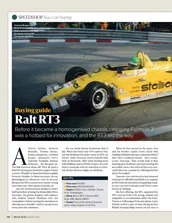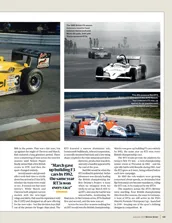

Race car buying guide: Ralt RT3
Ayrton Senna, Martin Brundle, Tommy Byrne, Stefan Johansson, Gerhard Berger, Emanuele Pirro, Gabriele Tarquini, Ronnie Peterson… the list goes on. The link between them all? They all used a Ralt…
HIGH SPEEDS IN THE MOROCCAN INTERNATIONAL RALLY
After studying the regulations for the Morroccan International Rally, 1935, one can only form the opinion that the successful cars and drivers will have proved their worth in a really severe test.
Reliable Speed has been made the deciding factor in the Rally, high average speed for several days .n end. From all the European starting controls, Paris, London, Brussels, Berlin, Warsaw, Prague, and Rome, the set average speed is 31m.p.h. throughout. This sounds quite mild, but once across the Straits of Gibraltar the real business of the Rally begins. Incidentally, there is also an itinerary from Sfax, in North Africa, and from here to Tangier the same average speed of 31 m.p.h. has to be maintained.
Before dealing with the African section, it is worth remarking that complete freedom is allowed as to choice of routebetween the controls en route to Gibraltar. The controls will have to be entered at the definite time stated on Road Cards, but no restriction is placed on the speed of competitors between the controls, so that it will be possible to snatch a few hours sleep outside the controls.
Late arrival at Gibraltar (from Europe) and Tangier (from Sfax) will be penalised by 20 points per minute or part of a minute. Early arrivals will be allowed passage through the control 30 minutes before the official opening time.
The next day the most difficult part of the Rally begins. The Moroccan section is divided into four ” laps,” with a different set average speed for each. They are as follow : Tangier-Meknes, 427 miles (43im.p.h.) ; Meknes-Marrakech, 348 miles (421 m.p.h.) ; MaxakechAgadir, 362 miles (341 m.p.h.) ; AgadirCasablanca, 354 miles (47 m.p.h.). But that is by no means all. At Tangier the competitors will have to take .part in a hill-climb at the “Mountain,’ without option. The classes will be under 1,500 c.c., 3,000 c.c., 5,000 c.c:,
and unlimited. Supercharged cars will be handicapped by an increase of 40 per cent. of their .cubic capacity. Drivers only will be in the cars during the hillclimb, in case of accidents, and the passengers will be replaced by 60 kilo sandbags, one for each passenger.
The marking for the hill-climb is exacting, for only those cars making the best time in their class will escape penalisation. All the rest will lose half a point per second, or part of a second, between their time and that of the fastest man in the class.
During the stay at Tangier, and at the closed parks at the end of each lap, the cars will be out of reach of all repairs and adjustments, and sufficient petrol has to be taken on at Gibraltar to suffice for the hill-climb.
Even now the competing cars have not been tested to the full, and an aeceleration and braking test will be held at Mekenes. With engines running, the cars will be given the word ” G ! and will accelerate for 500 metres, stopping on a line. They will then immediately reverse back for 50 metres, stopping on another line. Points will be scored in proportion to the time taken for the whole manoeuvre.
The penalty for being late at the end of each of the four sections in Morocco will be 5 points per minute, or part of a minute. On arrival at Casablanca the verification will immediately be carried out, and the various penalties are as follow : Hood not required size or impossible to raise, 10 points ; absence of hood, 40 points ; starter not working, 5 points ; hooter not working, 5 points ; lack of driving mirror, 10 points ; inefficient silencer, 5 points ; headlights not working, 5 points ; dimming system not working, 5 points ; lack of dimming -system, 30 points ; for each additional lamp not working, 5 points. The organisers are of the opinion that a
definite finishing order should be reached, and therefore no ties will be allowed. All competitors whose marks coincide with others will have to take part in an eliminating test. This consists of performing the following manatuvre twice : drive car to starting line from closed park, without ballast or passengers ; stand beside car with engine stopped ; on starting signal, enter the car, start engine with self-starter, and accelerate to line 100 metres away. Stop car, and reverse back to starting line. The mean speed of the two performances will count. In order to scale up the competitors on an even basis, the cars of 1,500-3,000 c.c. will add 2 seconds to their mean speed, those of 3,000 to 5,000 c.c. 4 seconds, and the unlimited cars 5 seconds.
Bearing in mind that there are two tests in which reversing plays an important part, wise competitors will fit a high reverse gear to their gearbox, while serious reversing and braking practice would not be amiss.
There will be three main categories, i.e., general classification, cars up to 1,500 c.c. and motor-coaches, with first prizes of 30,000, 8,000 and 5,000 francs respectively. The total prize money ‘amounts to 93,000 francs.
The entry fee is 1,250 francs per car for European competitors, while those using Sfax as their starting control will only have to pay 1,000 francs. The fee includes the cost of transportation across the Straits of Gibraltar. Entries close on March 1st.
It would be really instructive if British manufacturers could:see their way to entering for this first-class event. As a test of the car it is of greater value, in our opinion, than the Monte Carlo Rally, for the hill-climb, simple acceleration and braking test, and high average speed of the Moroccan section will surely reveal any weaknesses, and at the same time demand a car of high general performance.